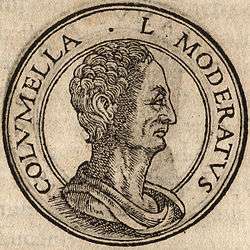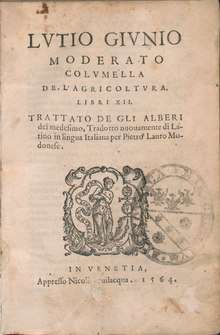Columella
Lucius Junius Moderatus Columella (/ˌkɒljəˈmɛlə/; Arabic: Yunius[1], 4 – c. 70 AD) was a prominent writer on agriculture in the Roman empire.[2]
Lucius Junius Moderatus Columella | |
|---|---|
 Portrait of Lucius Junius Moderatus Columella from Jean de Tournes, Insignium aliquot virorum icones, Lyon, 1559 | |
| Born | 4 AD Gades, Hispania Baetica |
| Died | c. 70 AD |
| Citizenship | Roman |
| Notable works | De Re Rustica |
His De re rustica in twelve volumes has been completely preserved and forms an important source on Roman agriculture, together with the works of Cato the Elder and Varro, both of which he occasionally cites. A smaller book on trees, De arboribus, is usually attributed to him.
In 1794 the Spanish botanists Jose Antonio Pavón y Jimenez and Hipólito Ruiz López named a genus of Peruvian asterid Columellia in his honour.[3]
Personal life
Little is known of Columella's life. He was probably born in Gades, Hispania Baetica (modern Cádiz), possibly to Roman parents. After a career in the army (he was tribune in Syria in 35), he turned to farming his estates at Ardea, Carseoli, and Alba in Latium.[4]
De re rustica
In ancient times, Columella's work "appears to have been but little read", cited only by Pliny the Elder, Servius, Cassiodorus, and Isidorus, and having fallen "into almost complete neglect" after Palladius published an abridgement of it.[5]
This book is presented as advice to a certain Publius Silvinus. Previously known only in fragments, the complete book was among those discovered in monastery libraries in Switzerland and France by Poggio Bracciolini and his assistant Bartolomeo di Montepulciano during the Council of Constance, between 1414 and 1418.[6]
Structure of De re rustica ("On Rural Affairs"):
- soils
- viticulture
- fruits
- olive trees
- big animals: cattle, horses and mules
- small animals: asses, sheep, goats, pigs, dogs
- fish and fowl: chickens, doves, thrushes, peacocks, Numidian chicken and guinea fowl, geese, ducks, fish ponds
- wild animals: enclosures for wild animals, bee-keeping, production of honey and wax
- gardens
- personnel management
- calendars
- household management
Book 10 is written entirely in dactylic hexameter verse, in imitation of or homage to, Virgil. It may initially have been intended to be the concluding volume, books 11 and 12 being perhaps an addition to the original scheme.[7]
A complete but anonymous translation into English was published by Millar in 1745.[8] Excerpts had previously been translated by Bradley.[9]
De arboribus

The short work De arboribus, "On Trees", is in manuscripts and early editions of Columella considered as book 3 of De Re Rustica.[10] However it is clear from the opening sentences that it is part of a separate and possibly earlier work. As the anonymous translator of the Millar edition notes (p. 571), there is in De arboribus no mention of the Publius Silvinus to whom the De Re Rustica is addressed.[8] A recent critical edition of the Latin text of the De Re Rustica of Columella includes it, but as incerti auctoris, by an unknown hand.[11] Cassiodorus mentions sixteen books of Columella, which has led to the suggestion that De arboribus formed part of a work in four volumes.[10]
Sources
In addition to Cato the Elder and Varro, Columella used many sources that are no longer extant and for which he is one of the few references. These include works by Aulus Cornelius Celsus, the Carthaginian writer Mago, Tremellius Scrofa, and many Greek sources. His uncle Marcus Columella, "a clever man and an exceptional farmer" (VII.2.30), had conducted experiments in sheep breeding, crossing colourful wild rams, introduced from Africa for gladiatorial games, with domestic sheep,[12] and may have influenced his nephew's interests. Columella owned farms in Italy; he refers specifically to estates at Ardea, Carseoli, and Alba,[13] and speaks repeatedly of his own practical experience in agriculture.
Principal early editions
The earliest editions of Columella group his works with those on agriculture of Cato the Elder, Varro Reatinus and Palladius. Some modern library catalogues follow Brunet in listing these under "Rei rusticae scriptores" or "Scriptores rei rusticae".[14]
- Iunii Moderati Columellae hortulus [Rome: Printer of Silius Italicus, ca. 1471] (book X only)
- Georgius Merula, Franciscus Colucia (eds.) De re rustica Opera et impensa Nicolai Ienson: Venetiis, 1472.
- Lucii Iunii Moderati Columellae de Cultu hortorum Liber .xi. quem .Pub. Virgilius .M. i[n] Georgicis Posteris edendum dimisit. [Padova]: D[ominicus] S[iliprandus], [ca. 1480]
- Opera Agricolationum: Columellæ: Varronis: Catonisque: nec non Palladii: cū excriptionibus .D. Philippi Beroaldi: & commentariis quæ in aliis impressionibus non extāt. Impensis Benedicti hectoris: Bonon., xiii. calen. octob. [19 Sept.], 1494
- Beroaldo, Filippo "il vecchio" Oratio de felicitate habita in enarratione Georgicon Virgilii et Columellae Bononiae: per Ioannemantonium De Benedictis, 1507
- Lucii Junii moderati Columell[ae] de cultu hortorum carme[n] : Necno[n] [et] Palladius de arboru[m] insitione una cu[m] Nicolai Barptholomaei Lochensis hortulo. Parisiis: Venundantur parisiis in aedibus Radulphi Laliseau [printed by Jean Marchant], [1512] (poetry sections only)
- Columella, Lucius Iunius Moderatus Columella De cultu ortorum. Interprete Pio Bononiensi. Impressum Bononiae: a Hieronymo de Benedictis bibliopola et calcographo, 1520 mense Augusto
- Libri De Re Rustica...Additis Nuper Commentariis Iunii Pompo. Fortunati in Librum De Cultu Hortorum, Cum Adnotationibus Philippi Beroaldi... Florence: Filippo Giunta, 1521
- De re rustica libri XII. Euisdem de Arboris liber, separatus ab aliis. Lyon, Sébastien Gryphe, 1541
- Columella, Lucius Iunius Moderatus De l'agricoltura libri XII. / Lutio Giunio Moderato Columella. Trattato de gli alberi, tradotto nuouamente di latino in lingua italiana per Pietro Lauro Modonese In Venetia: [Michele Tramezzino il vecchio], 1544
- Les Douze livres des choses rustiques. Traduicts de Latin en François, par feu maistre Claude Cotereau Chanoine de Paris. La traduction duquel ha esté soingneusement reveue & en la plupart corrigée, & illustrée de doctes annotations par maistre Jean Thierry de Beauvoisis Paris: Jacques Kerver, 1551, 1555
- Columella, Lucius Junius Moderatus Les douze liures ... des choses rustiques, tr. par C. Cotereau. La tr. corrigée & illustrée de doctes annotations par J. Thiery de Beauoisis Paris, 1555
- Columella, Lucius Iunius Moderatus Lutio Giunio Moderato Columella De l'agricoltura libri XII. Trattato de gli alberi del medesimo, tradotto nuouamente di latino in lingua italiana per Pietro Lauro modonese. In Venetia: per Geronimo Caualcalouo, 1559
- Columella, Lucius Iunius Moderatus Lutio Giunio Moderato Columella De l'agricoltura libri XII. Trattato de gli alberi tradotto nuovamente di latino in lingua italiana per Pietro Lauro modonese. In Venetia: appresso Nicolò Beuilacqua, 1564
- Orsini, Fulvio Notae ad M. Catonem, M. Varronem, L. Columellam de re rustica. Ad kalend. rusticum Farnesianum & veteres inscriptiones Fratrum Arvalium. Iunius Philargyrius in Bucolica & Georgica Virgilij. Notae ad Servium in Bucol. Georg. & Aeneid. Virg. Velius Longus de orthographia : ex bibliotheca Fulvi Ursini Romae: in aedib. S.P.Q.R. apud Georgium Ferrarium, 1587[15]
- Bradley, Richard A Survey of the Ancient Husbandry and Gardening collected from Cato, Varro, Columella, Virgil, and others, the most eminent writers among the Greeks & Romans: wherein many of the most difficult passages in those authors are explain'd ... Adorn'd with cuts, etc. London: B. Motte, 1725
- Gesner, Johann Matthias (ed.) Scriptores Rei Rusticae veteres Latini Cato, Varro, Columella, Palladius, quibus nunc accedit Vegetius de Mulo-Medicina et Gargilii Martialis fragmentum (Ausoni Popinæ De instrumento fundi liber. J. B. Morgagni epist. IV.) cum editionibus prope omnibus et MSS. pluribus collati: adjectae notae virorum clariss, integræ ... et lexicon Rei Rusticae curante Io. Matthia Gesnero Lipsiae: sumtibus Caspari Fritsch, 1735 (full text)
- Lucius Junius Moderatus Columella (trans. Anon.) L. Junius Moderatus Columella of Husbandry, in Twelve Books: and his book, concerning Trees. Translated into English, with illustrations from Pliny, Cato, Varro, Palladius and other ancient and modern authors London: A. Millar, 1745
See also
- Junia (gens)
- Ancient Rome and wine
References
- Medieval Science, Technology, and Medicine: An Encyclopedia. Taylor and Francis.
- "Columella - Classics - Oxford Bibliographies - obo". Retrieved 3 April 2018.
- Michaud, Joseph Fr., Eugène Ernest Desplaces, Louis Gabriel Michaud (1854). Biographie universelle (Michaud) ancienne et moderne ... (in French). Madame C. Desplaces. p. 668, vol. 8. Accessed June 2011.
- von Stackelberg, Katharine T. (2012). "Columella". The Encyclopedia of Ancient History. American Cancer Society. doi:10.1002/9781444338386.wbeah06080. ISBN 9781444338386.
- Peck, Harry Thurston, ed. (1963) [1898]. "Columella, L. Iunius Moderātus". Harper's Dictionary of Classical Literature and Antiquities. New York: Cooper Square Publishers, Inc. pp. 383–84.
- Shepherd, William (1802). The life of Poggio Bracciolini. London, Liverpool: T. Cadell, Jun., & W. Davies. pp. iv, 487.
- Kenney, E.J. (ed); W.V. Clausen (1982). The Cambridge history of classical literature, vol. 2: Latin literature. Cambridge: Cambridge University Press. p. 973. ISBN 978-0-521-21043-0.CS1 maint: extra text: authors list (link)
- Lucius Junius Moderatus Columella (1745). L. Junius Moderatus Columella of Husbandry, in Twelve Books: and his book, concerning Trees. Translated into English, with illustrations from Pliny, Cato, Varro, Palladius and other ancient and modern authors. London: A. Millar. pp. xiv, 600.
- Bradley, Richard (1725). A Survey of the Ancient Husbandry and Gardening collected from Cato, Varro, Columella, Virgil, and others, the most eminent writers among the Greeks & Romans: wherein many of the most difficult passages in those authors are explain'd ... Adorn'd with cuts, etc. London: B. Motte. p. 373.
- Society for the Diffusion of Useful Knowledge (1837). Penny Cyclopaedia of the Society for the Diffusion of Useful Knowledge. C. Knight. p. 380, volumes 7–8.. Accessed June 2011.
- Rodgers, R.H. (ed.) (2010). L. Iuni Moderati Columellae Res rustica. Incerti auctoris Liber de arboribus (in Latin). Oxonii [Oxford, England]: E Typographeo Clarendoniano. ISBN 978-0-19-927154-2.CS1 maint: extra text: authors list (link) Accessed June 2011.
- Diderot, Denis, Jean Le Rond d' Alembert (eds.) (1765). Encyclopédie ou Dictionnaire raisonné des sciences, des arts et des métiers ... Neufchatel: S. Faulche. p. 179, vol. 9 JU–MAM.CS1 maint: extra text: authors list (link) Accessed June 2011.
- "De re rustica (English translation) III.9.2". Loeb Classical Library edition, 1941. Accessed June 2011.
- Brunet, Jacques-Charles (1843). Manuel du libraire et de l'amateur de livres, vol 4., R–Z (in French) (4th ed.). Paris: Silvestre. p. 238. Accessed May 2011.
- Orsini, Fulvio (1587). Notae ad M. Catonem, M. Varronem, L. Columellam de re rustica. Ad kalend. rusticum Farnesianum & veteres inscriptiones Fratrum Arvalium. Iunius Philargyrius in Bucolica & Georgica Virgilij. Notae ad Servium in Bucol. Georg. & Aeneid. Virg. Velius Longus de orthographia : ex bibliotheca Fulvi Ursini (full text online, two copies). Romae: in aedib. S.P.Q.R.: apud Georgium Ferrarium.
Further reading
- Baldwin, Barry. 1963. "Columella’s Sources and How He Used Them." Latomus 22:785–791.
- Bertoni, D. 2017. “Geometry and Genre in Columella.” American Journal of Philology. 138.3: 527-554.
- Carandini, Andrea. 1983. "Columella’s Vineyard and the Rationality of the Roman Economy." Opus 2:177–204.
- Carroll, Peter D. 1976. "Columella the Reformer." Latomus 35:783–790.
- Doody, Aude. 2007. "Virgil the Farmer? Critiques of the Georgics in Columella and Pliny." Classical Philology. 102.2: 180-197.
- Dumont, Jean Christian. 2008. "Columella and Vergil." Vergilius 54:49–59.
- Forster, E. S. 1950. "Columella and His Latin Treatise on Agriculture." Greece and Rome 19:123–128.
- Gowers, Emily. 2000. "Vegetable Love: Virgil, Columella, and Garden Poetry." Ramus 29:127–148.
- Henderson, John. 2002. "Columella's Living Hedge: the Roman Gardening Book." The Journal of Roman Studies 92: 110-133.
- Olson, L. 1943. "Columella and the Beginning of Soil Science." Agricultural History 17:65–72.
External links
| Wikiquote has quotations related to: Columella |
| Library resources about Columella |
| By Columella |
|---|